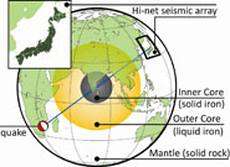New insights into centre of the Earth

A new observation of the very deepest part of the Earth, the solid inner core, has been reported this week in Nature. The team from the University of Bristol also observed intriguing evidence of a ‘texture’ in the solid iron that may reflect the patterns left as the swirling liquid iron of the outer core freezes to form the inner core.
Researchers at the University of Bristol have measured ‘PKJKP’ – an elusive seismic wave which traverses the Earth’s solid inner core – with greater precision than ever before. This was achieved using Hi-net, an array of over 750 seismometers which span the Japanese islands and are designed to provide earthquake warnings.
Dr James Wookey, lead author on the study, said: “The Earth’s solid inner core started to form over a billion years ago when the liquid iron core that surrounds it became cool enough to begin solidifying. It has now grown to a radius of around 1200 km. But the difficulty in studying it is the thousands of kilometres of rock in the way. As a result, we know more about the surfaces of other planets than we do about the deep interior of our own. However, we have a powerful tool for studying the inner architecture of the Earth.”
When large earthquakes or powerful explosions occur, vibrations (like sound waves) travel throughout the Earth and seismometers can detect these ‘seismic waves’ at great distances, even on the opposite side of the planet. By studying the characteristics of these waves (eg, how long they take to reach us, how strong they are) we can infer many things about the deep Earth.
The most recent advances in seismology have come from simultaneous observations of these waves using large numbers of instruments in dense networks. At present, the biggest of these arrays is the Japanese Hi-net array. This network, built for providing earthquake warnings, consists of over 750 seismometers across all of the Japanese islands, each installed in a borehole between 100m and 2km deep.
George Hefflich, Professor of Seismology at the University of Bristol, and also an author on the paper, said: “A side benefit of this network is that the data can also be used to study the deep Earth, looking for extremely faint vibrations passing through the very centre of the planet. One such subtle signal is the seismic wave called ‘PKJKP’. The properties of this wave contain a wealth of information about the Earth’s inner core”.
As well as showing direct evidence of the solidity of the Earth’s inner core, the team observed evidence of ‘texturing’ of the iron of the inner core. This may reflect the patterns left as the swirling liquid iron of the outer core freezes.
More observations like this will allow seismologists to start to understand these patterns, and what they imply for how the very deepest part of our planet has changed throughout the Earth’s history.
The Earth has been cooling since its birth from the fiery debris of the early Solar System four-and-a-half billion years ago. Earthquakes, volcanoes, the movement of continents, and the Earth's magnetic field are all, ultimately, expressions of convection caused by heat being transported from the hot interior to the cooler exterior. At the very centre of the Earth is the most striking evidence of this cooling – the frozen inner core.
This research is published in Nature: www.nature.com/nature/journal/ … abs/nature07131.html
Provided by University of Bristol




















